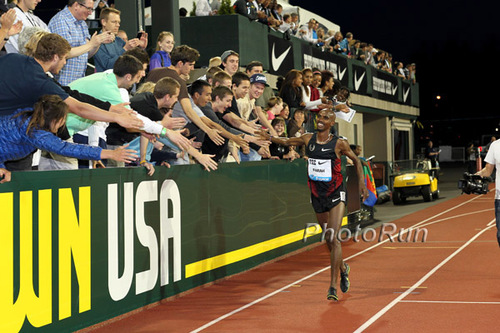How do we get Track & Field on TV more? How do we present it better? How do we get Track & Field on TV as a real option for sports on TV? Dave Hunter provides some strong ideas. The key is communicating the excitement that real fans see on TV, and how often Track on TV is an option.
RelatedPosts
Track & Field On Television
January 5th, 2014
Why isn’t track & field more popular? “For God’s sake, track & field is the sport from which all other sports emerged!” laments Peter Walsh, proprietor of Coogan’s Irish Pub and Restaurant – track & field’s famed watering hole. “Why are we such lousy marketers?” he cries.
A big piece of the puzzle is television. Track & field is rarely on TV. But it shouldn’t be that way. With its origin tracing back to pre-biblical times, track & field has a heritage that clearly affirms its claim as the wellspring of all current sports. Our sport offers the simple and clean  objectivity of determining who can run the fastest, jump the highest, or throw the farthest without being smudged by subjective judging or “style points.” Furthermore, current national data demonstrates that track & field – when combined with cross country – is the number one high school participatory sport in the nation. That is why there is a legion of viewers – track & field fans and others – who are confident that a crisply-assembled, up-tempo video presentation of the purest of athletic competition can be intrinsically more compelling than NASCAR, cage fighting, or Dancing With The Stars.
objectivity of determining who can run the fastest, jump the highest, or throw the farthest without being smudged by subjective judging or “style points.” Furthermore, current national data demonstrates that track & field – when combined with cross country – is the number one high school participatory sport in the nation. That is why there is a legion of viewers – track & field fans and others – who are confident that a crisply-assembled, up-tempo video presentation of the purest of athletic competition can be intrinsically more compelling than NASCAR, cage fighting, or Dancing With The Stars.
To be sure, social media is making inroads into television’s broadcast dominance. And frankly – with sites like Flotrack, RunnerSpace, and others – our sport is doing a solid job of utilizing social media to inform about track & field, its purity, and its inherent excitement. But in our culture television has been – and will remain – the overwhelmingly most powerful medium for reaching a broad-based audience. It simply cannot be denied: American track & field’s pathway for more visibility, a larger fan base, an even higher quality for its corps of elite athletes, an expanded corporate support, and the inflow of more money into the sport is a greater and more effective presence on television.
It’s not that track & field isn’t on TV. It just isn’t on TV enough. “If you want to watch a hockey game, you can find it,” explains Dr. Norbert Sander, Executive Director of The Armory Foundation. “We get a track meet on television once every 6 months.”
Scarcity of track & field television broadcasts is not the only obstacle. When a track meet is on TV, the telecast is often lacking the tightly-scripted, fast-moving presentation calculated to attract and hold the attention of the fans, the curious, and – not unimportantly – the current and potential sponsors. Crisper video is the key. Currently – after a televised sprint false start – it is almost painful to watch as 8 blasé sprinters leisurely saunter back to the blocks and off-guard commentators struggle to fill the dead air time. You can almost hear the channel being changed across the country. Track & field is unduly hung up on real time presentation. It would be far better to abandon overblown concern about being scooped by Twitter and to present an efficiently edited 110 meter hurdle final 10 minutes after the fact. In doing so, the final could be quickly edited and its broadcast would eliminate the real time risk of forcing a viewing audience to watch athletes stroll back to the starting line after a false start while hurdles are being reset. The sport we love could take a lesson from PGA tour broadcasts. Professional golf routinely packages and delivers telecasts sprinkled with slightly-delayed clips (e.g. Jim Nantz on Masters’ Sunday: “This happened moments ago at 14…”).
Tempo and timing are also crucial. Track & field has often been compared to a three-ring circus. At its finest, it is. But do we really capture the up-tempo swirl of events in domestic broadcasts of the sport? We could present the genuine multi-faceted drama of the sport with a greater dedication of on-field telecasters and cameras. Again, look at PGA broadcasts. They have at least one analyst and three camera angles – on every hole! With a fraction of that dedication of resources to championship track and field telecasts, the excitement of the sport would truly be captured for all viewers to savor.
Broadcast duration has to be tailored to the intolerant attention span of today’s viewer. There is a reason why television broadcasts – be it movies, sporting events, or documentaries – are rarely longer than 2 hours: 120 minutes is it and then everyone moves on. But how do we cater to the hard core fans who take offense at abbreviated coverage of the distance races or the nodding footage accorded to the field events? The suggestion: television neatly packages for broadcast the critical moves and the final lap of 10,000 and the record setting attempt in the field event and directs the viewer to a website where the rabid can drink in all 25 laps of the 10K as well as study all 6 heaves of Amanda Bingson’s American record-setting hammer throw series. The result: a tightly scripted, crisp broadcast for the greater audience and an on-air roadmap provided to the fanatic who seeks more.
Respected leaders in the sport clearly recognize the enormous king-making capability of television. And they are working feverishly to showcase the attractiveness of track & field to those in the media who hold the crown. “What we’re trying to do here is to build an indoor season,” explains Sander, as he outlines a shared vision of a 5 or 6 week televised indoor season featuring the sport’s biggest stars in several major U.S. cities which would be capped by the indoor national championship meet. “We want to get this on live TV,” explains Sander. “We want to get to the point where every Saturday afternoon at 3:00 p.m. you see a track meet on television. TV will do this, but we have to give them something,” implores Sander. We have something to give TV. Let’s be smart enough to give it to them.
~Dave Hunter






















